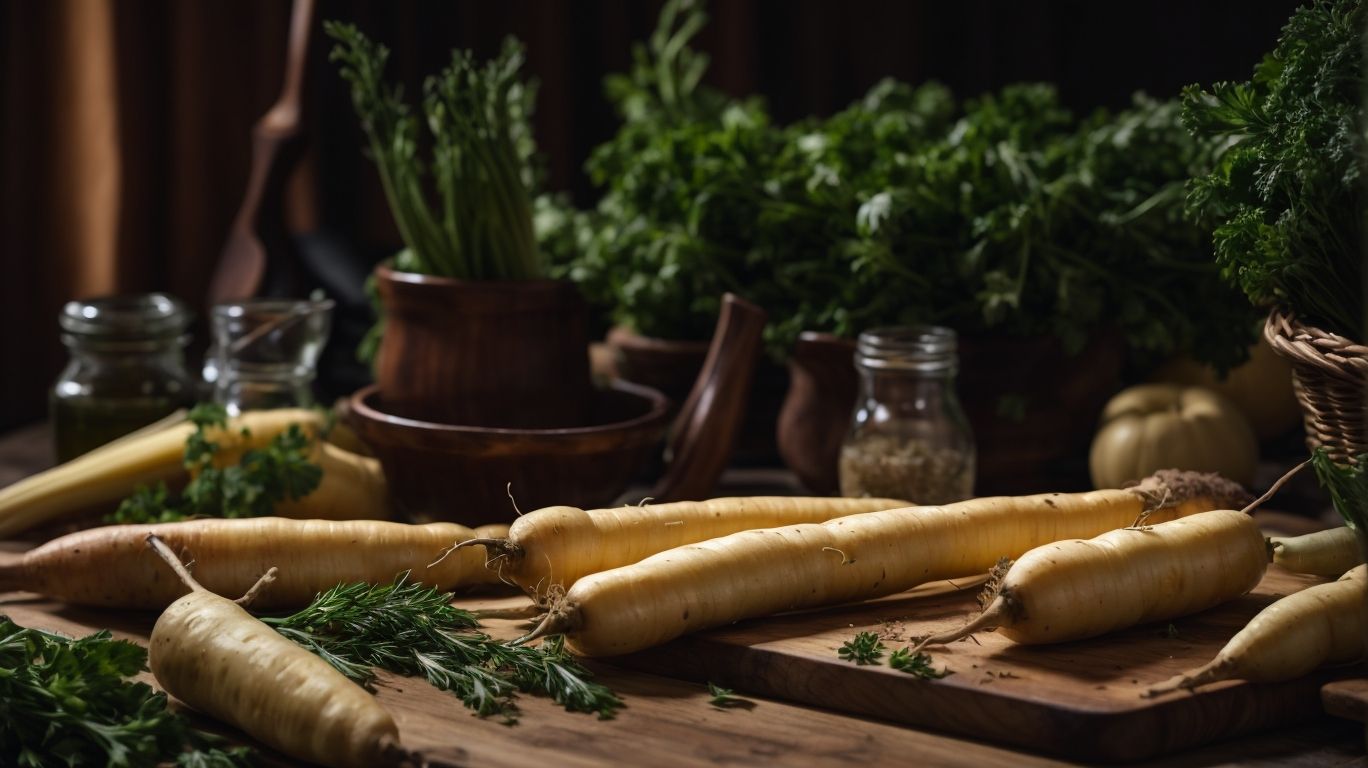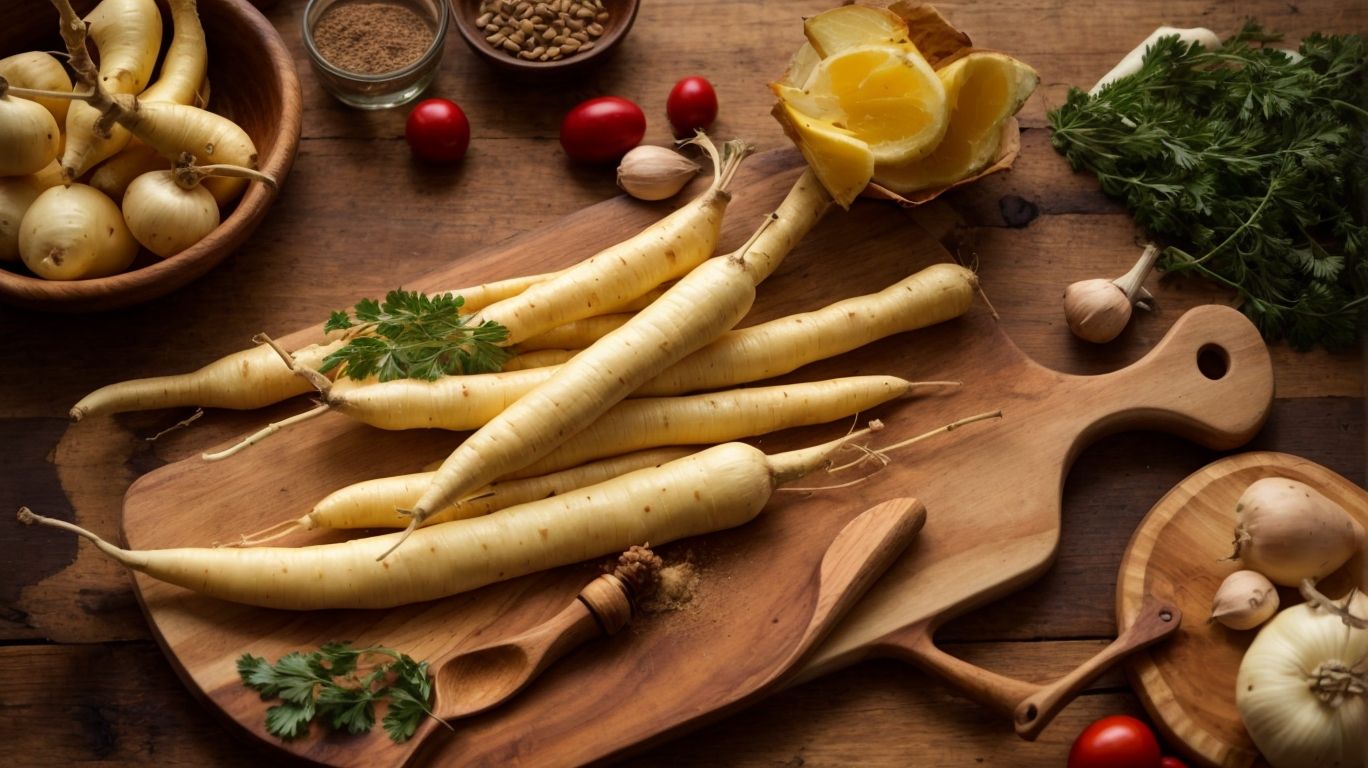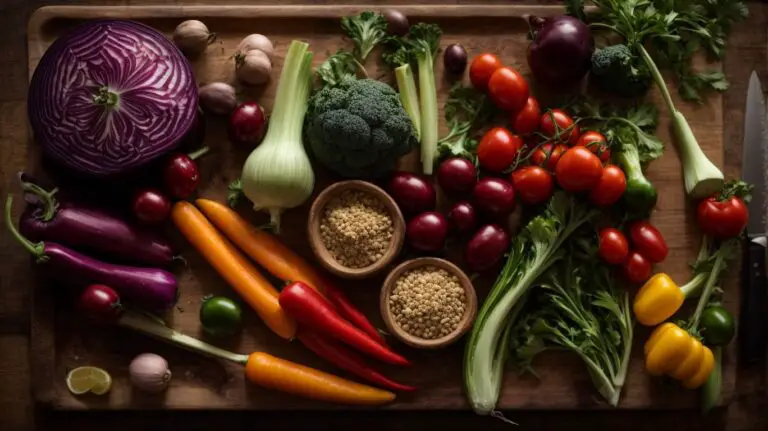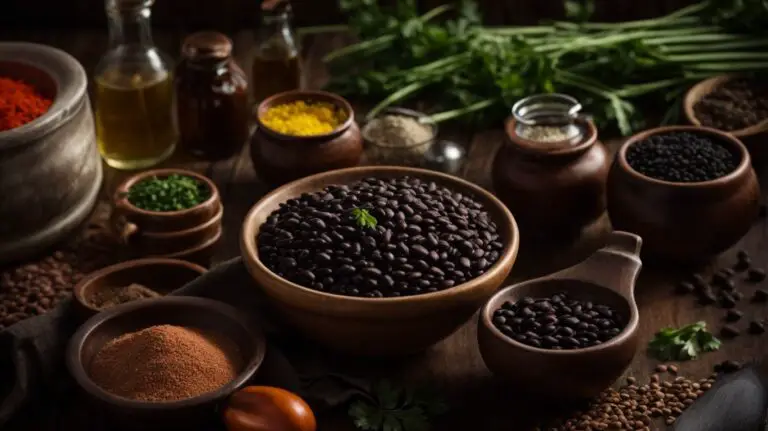How to Cook Parsnips?
Looking to add a versatile and nutritious vegetable to your cooking repertoire? Look no further than parsnips!
We will explore the health benefits of parsnips, how to select and store them, prepare them for cooking, and delicious dishes you can make with this underrated root vegetable.
Whether you’re a seasoned chef or just starting out in the kitchen, these tips and recipes will help you make the most of this flavorful ingredient. Let’s get cooking with parsnips!
Key Takeaways:
About Parsnips
Parsnips, a delicious root vegetable, are a versatile ingredient in the culinary world, offering a unique flavor profile that adds depth to various dishes.
Often described as a cross between carrots and potatoes, parsnips bring a sweet and earthy taste to recipes, making them a popular choice in soups, stews, and roasts. Their natural sweetness intensifies when roasted, caramelizing beautifully to create a delectable side dish.
Rich in fiber and antioxidants, parsnips not only enhance the taste of your meals but also offer numerous health benefits. They are a staple in traditional dishes across Europe and are now gaining popularity in modern cuisines worldwide. Whether mashed, fried, or pureed, parsnips never fail to impress the palate.
What are the Health Benefits of Parsnips?
Parsnips, a nutritious vegetable, offer a range of health benefits due to their rich content of vitamins, minerals, and fiber, making them a valuable addition to a balanced diet.
High in essential nutrients, parsnips are a great source of fiber, vitamin C, potassium, and folate. Vitamin C supports a healthy immune system, while potassium helps regulate blood pressure. The fiber in parsnips aids digestion and promotes a feeling of fullness, which can assist in weight management. These root vegetables are versatile in culinary applications, lending a sweet and earthy flavor to dishes like soups, stews, and roasted vegetable medleys.
High in Fiber
Parsnips are notably high in fiber, a crucial component that supports digestive health and promotes a feeling of fullness, aiding in weight management.
Fiber plays a vital role in maintaining a healthy digestive system by regulating bowel movements and preventing constipation. A high-fiber diet can help lower cholesterol levels and reduce the risk of developing heart disease. Notably, parsnips’ fibrous content contributes to a longer-lasting feeling of satiety, which can assist in controlling food intake and supporting weight loss efforts. Including parsnips in your diet can be a delicious and nutritious way to boost your overall nutrition and enhance the health benefits of your meals.
Rich in Vitamins and Minerals
Parsnips are rich in various vitamins and minerals, such as vitamin C, potassium, and folate, which play essential roles in supporting overall health and well-being.
Vitamin C, found abundantly in parsnips, is crucial for immunity and collagen formation, promoting healthy skin and wound healing. Potassium, another key nutrient, aids in heart health and maintaining proper blood pressure. Folate, also known as vitamin B9, supports cell division and helps prevent certain birth defects. Including parsnips in your diet can provide a range of essential nutrients to keep you energetic and healthy.
Lowers Blood Pressure
Consuming parsnips may help lower blood pressure levels due to their potassium content, a mineral known for its role in regulating blood pressure and heart health.
Aside from potassium, parsnips are also packed with fiber, vitamin C, and folate, all of which play crucial roles in supporting overall cardiovascular health. The fiber content helps lower cholesterol levels, reducing the risk of heart disease.
Incorporating parsnips into your diet can contribute to better digestion and weight management, thanks to their low calorie and high nutrient profile. These root vegetables have a naturally sweet flavor that can add depth to various dishes, making them a versatile and nutritious addition to any meal.
Boosts Immune System
Parsnips contribute to a robust immune system as they contain vitamin C, an essential nutrient for immune function, helping the body defend against illnesses and infections.
Research suggests that a diet rich in vitamin C can enhance the production of white blood cells, which are crucial for fighting off pathogens and maintaining overall health. The antioxidant properties of vitamin C help protect cells from damage by free radicals, thus reducing the risk of chronic diseases.
Incorporating parsnips into your regular food intake can boost your health by supporting a strong immune response. It’s essential to prioritize nutrient-dense options like parsnips to fortify your body’s defense mechanisms and promote overall well-being.
How to Select and Store Parsnips?

Credits: Poormet.Com – Gabriel Wright
Selecting and storing parsnips properly is essential to maintain their freshness and flavor, ensuring optimal results in your culinary creations.
When you purchase parsnips, look for firm roots with smooth skin and avoid any signs of softness or discoloration. Fresh parsnips should have a pale beige color and a bit of weight to them.
Once you bring them home, it’s best to store them in a cool, dark place such as the refrigerator’s crisper drawer, wrapped in a damp paper towel to retain moisture.
Avoid washing them before storing, as excess moisture can lead to spoilage. If stored properly, parsnips can last up to 2-3 weeks. To ensure the best flavor and texture, it’s advisable to use them within a week of purchase.
Choosing Fresh Parsnips
When selecting fresh parsnips, look for firm, smooth roots with no signs of softness or blemishes, ensuring quality and freshness for your dishes.
To identify the best parsnips, choose ones that feel heavy for their size, indicating moisture content and density. Avoid roots that appear wilted or have wrinkled skin, as these are likely old or dehydrated. Opt for parsnips with vibrant skin color, as dull or discolored roots may suggest lack of freshness. Remember that smaller parsnips are typically sweeter and more tender, making them ideal for various culinary uses. By paying attention to these visual cues, you can confidently purchase top-quality parsnips for your recipes.
Storing Parsnips
To store parsnips, keep them in a cool, dark place like the pantry or a root cellar, ensuring proper airflow to maintain their texture and flavor over time.
When choosing a spot in the pantry or root cellar for storing parsnips, make sure to select an area away from sources of light and heat.
This will prevent premature sprouting or loss of moisture, which can lead to a decline in quality.
Storing parsnips in a breathable container, such as a paper bag or perforated plastic bag, can help regulate humidity levels and prevent mold growth.
How to Prepare Parsnips for Cooking?
Preparing parsnips for cooking involves peeling, cutting, and various techniques like roasting to enhance their natural flavors and caramelized sweetness.
To start, ensure you choose firm, medium-sized parsnips without any soft spots. After thoroughly washing the parsnips, use a vegetable peeler to remove the tough outer skin. Once peeled, trim off the ends and cut the parsnips into even-sized pieces to ensure uniform cooking. For a delicious roasted parsnip recipe, toss the cut pieces with olive oil, salt, pepper, and a sprinkle of rosemary before placing them on a baking sheet. Roast in a preheated oven until the edges are crispy and golden brown. This simple yet flavorful method brings out the best in parsnips, making them a delightful addition to any meal.
Peeling and Cutting
Properly peeling and cutting parsnips is essential before cooking to ensure uniform pieces and optimal cooking results, enhancing the overall presentation of the dish.
One key technique for peeling parsnips is to use a vegetable peeler or a sharp knife, carefully removing the outer skin to reveal the creamy flesh underneath. Regarding cutting, it’s important to maintain consistent thickness in slices or dices to promote even cooking.
In a busy kitchen setting, efficiency is key. Prepping the parsnips ahead of time by washing, peeling, and cutting them in batches can save time and streamline the cooking process.
Remember to always observe safety measures when handling sharp knives, ensuring proper grip and posture to prevent accidents and injuries in the kitchen.
Blanching
Blanching parsnips before cooking can help preserve their color, texture, and nutrients, resulting in vibrant and flavorful dishes.
Blanching is a culinary technique where food is briefly immersed in boiling water, then rapidly cooled in ice water to halt the cooking process. For parsnips, this process is essential to maintain their firm texture and earthy flavor. By blanching parsnips, you can lock in their natural sweetness and prevent them from becoming mushy during further cooking methods, such as roasting or sautéing. Blanching ensures that the parsnips retain their bright color, making your dishes more visually appealing. This method helps in deactivating enzymes that can cause spoilage, thus increasing the shelf life of the vegetables.
Roasting
Roasting parsnips in the oven enhances their natural sweetness and nutty flavor, resulting in caramelized edges and a delicious side dish for any meal.
When parsnips are roasted, the high heat of the oven helps bring out their inherent sugars, creating a beautifully caramelized exterior that adds a depth of flavor to each bite. The slow cooking process allows the flavors to intensify, giving the parsnips a rich and savory taste.
Roasting parsnips in the oven is not only delicious but also a healthier cooking method. By using minimal oil and letting the oven do the work, you can enjoy a tasty dish without excessive added fats, making it a guilt-free addition to your menu.
What Dishes Can You Make with Parsnips?
Parsnips offer a versatile canvas for culinary creativity, allowing you to prepare a variety of dishes such as parsnip soup, parsnip fries, and parsnip and apple salad.
These root vegetables possess a unique sweet and earthy flavor that lends itself well to both savory and sweet dishes. Whether roasted to enhance their natural sweetness or blended into a creamy soup for a comforting meal, parsnips are a delightful addition to any culinary repertoire. Their natural sugars caramelize beautifully when roasted, bringing out a depth of flavor that pairs wonderfully with various dishes. In salads, they add a crunchy texture and subtle sweetness, balancing out the flavors in each bite.
Parsnip Soup
Parsnip soup is a comforting and flavorful dish that highlights the natural sweetness and earthy notes of parsnips, perfect for a cozy meal.
Making parsnip soup starts with sautéing onions and garlic in a pot until fragrant, then adding diced parsnips, carrots, and celery for a depth of flavor.
The vegetables are simmered in vegetable broth until tender, allowing the ingredients to meld together harmoniously. A touch of cream or coconut milk adds richness and creaminess to the soup, enhancing its comforting qualities.
Seasoned with thyme, nutmeg, and a pinch of salt and pepper, this culinary masterpiece delivers a balanced flavor profile that delights the taste buds.
Parsnip Fries
Crispy parsnip fries are a delightful alternative to traditional potato fries, offering a sweet and nutty flavor profile that pairs well with various seasonings.
Preparing these delectable fries involves slicing parsnips into thin sticks to ensure a crispy texture when cooked. The natural sweetness of parsnips caramelizes beautifully in the oven or deep fryer, resulting in a slightly crispy exterior and a tender inside. One can experiment with seasoning options such as sea salt, black pepper, garlic powder, or even a sprinkle of rosemary for a herbaceous twist.
Parsnip Puree
Vevlety parsnip puree is a luxurious side dish that offers a smooth texture and rich flavor, ideal for complementing main courses or serving as a garnish.
To create this delectable puree, begin by washing and peeling fresh parsnips before chopping them into uniform pieces. Boil the parsnips until they are tender, then drain them well. Next, blend the parsnips with heavy cream or milk in a food processor until the mixture is silky smooth. For added richness, include a knob of butter or a drizzle of olive oil during blending. Season the puree with salt and pepper to taste, and consider introducing a hint of nutmeg or fresh herbs for extra depth of flavor.
Parsnip and Apple Salad
The combination of parsnips and apples in a vibrant salad offers a refreshing and balanced flavor profile, perfect for light and nutritious meals.
When crafting this wholesome dish, the sweet crispness of apples pairs harmoniously with the earthy notes of parsnips, creating a delightful contrast of textures and tastes. The crunch of the vegetables combined with the juiciness of the fruit provides a satisfying eating experience.
This salad is not only refreshing but also a nutritional powerhouse, packed with essential vitamins, minerals, and fiber. Parsnips are rich in potassium and vitamin C while apples offer a good dose of antioxidants, keeping your body healthy and energized.”
Parsnip and Carrot Mash
Parsnip and carrot mash is a comforting and flavorful side dish that combines the sweetness of carrots with the nuttiness of parsnips, creating a delicious accompaniment to meals.
This versatile dish can be prepared by boiling peeled and chopped parsnips and carrots until they are tender, then mashing them together with butter, salt, pepper, and a hint of nutmeg for added warmth and depth of flavor.
The result is a velvety mash that offers a unique combination of textures – the creamy smoothness of the carrots blending with the slightly grainy consistency of the parsnips.
For a twist on the classic recipe, consider adding roasted garlic or fresh herbs like thyme or rosemary to elevate the flavors further.
Parsnip and Potato Gratin
Parsnip and potato gratin is a decadent and savory dish that layers thinly sliced parsnips and potatoes with cream and cheese, creating a luscious and indulgent meal.
This dish stands out for its rich layers of flavors and contrasting textures. The sweetness of parsnips combined with the earthy undertones of potatoes, all bathed in a creamy sauce and topped with gooey, melted cheese, make it a true comfort food. The key to achieving the perfect balance lies in the careful slicing of the vegetables, ensuring they cook evenly and meld together into a cohesive whole.
To make this gratin, start by peeling and thinly slicing the parsnips and potatoes. Layer them in a baking dish, alternating between the two, and seasoning each layer with salt, pepper, and any desired herbs or spices. Pour a mixture of cream and milk over the top, allowing it to seep through the layers, then sprinkle generously with grated cheese. Bake in the oven until the top is golden brown and bubbly, and the vegetables are tender.
Parsnip and Bacon Hash
Parsnip and bacon hash is a hearty and flavorful dish that combines the earthy sweetness of parsnips with the savory richness of bacon, creating a satisfying meal.
This dish offers a delightful contrast of textures, with the crispy bacon complementing the tender parsnips, resulting in a harmonious blend of flavors. The caramelization of the parsnips adds a touch of sweetness, while the smokiness of the bacon infuses depth into each bite. The hash is often seasoned with fragrant herbs and spices, enhancing its overall aromatic profile. When served hot, this comforting dish warms both body and soul, making it a popular choice for leisurely weekend brunches or cozy weeknight dinners.
Tips for Cooking with Parsnips

Credits: Poormet.Com – Gregory Anderson
Enhance your culinary creations with parsnips by following these cooking tips that focus on flavor pairings, seasoning techniques, and ingredient substitutions for versatile meal preparation.
When cooking with parsnips, consider combining them with complementary flavors like honey, thyme, or garlic to enhance their natural sweetness. Seasoning plays a crucial role; experiment with different herbs, spices, and a touch of acidity from lemon or vinegar to balance the dish. Don’t be afraid to swap ingredients based on availability or personal preference – try using parsnips in place of potatoes in stews or purees for a unique twist. The versatile nature of parsnips makes them a fantastic addition to various dishes, from soups and salads to roasts and gratins.
Seasoning
Seasoning parsnips with herbs like rosemary, thyme, or a sprinkle of Parmesan can elevate their flavor profile and add aromatic depth to your dishes.
Experimenting with different herb combinations can bring out diverse taste dimensions in your parsnip dishes. For a classic and earthy flavor, try pairing parsnips with sage and garlic. If you prefer a touch of sweetness, consider using a bit of cinnamon along with nutmeg. Incorporating a hint of citrus zest or juice can provide a refreshing and zesty finish to your roasted or mashed parsnips.
Pairings
Consider pairing parsnips with ingredients like pork, chicken, or apples to create delicious and harmonious flavor combinations that elevate your culinary creations.
For a savory option, try roasting parsnips alongside pork tenderloin, allowing their sweet and earthy notes to complement the rich flavors of the meat. The natural sweetness of apples can balance out the slightly peppery undertones of parsnips, making them a perfect pairing for a comforting autumn stew.
When looking to experiment with different textures and flavors, consider incorporating parsnips into creamy purees with roasted chicken or adding them to hearty vegetable soups for a satisfying depth of flavor. The versatility of parsnips opens up a world of possibilities, from delectable side dishes to innovative main courses that showcase culinary creativity.
Substitutions
When cooking with parsnips, consider ingredient substitutions like carrots or sweet potatoes to add variety and adapt dishes to personal preferences or dietary requirements.
Carrots and sweet potatoes can be excellent alternatives to parsnips in a variety of culinary creations. Carrots offer a slightly sweeter flavor profile and vibrant color, while sweet potatoes bring a rich and earthy sweetness to dishes.
Ingredients like these can easily replace parsnips in soups, stews, and roasted vegetable medleys. Substituting with carrots can also provide a crunchier texture and appealing visual appeal, especially in salads or stir-fries. When exploring different culinary options, experimenting with these substitutions can lead to delightful surprises and new favorite recipes.
Conclusion
Parsnips stand as a versatile and flavorful ingredient in the culinary world, offering a spectrum of dishes, flavors, and techniques that cater to various tastes and preferences.
Parsnips are commonly praised for their natural sweetness and earthy undertones, making them a popular choice for both savory and sweet dishes. Their creamy texture when cooked adds a unique element to soups, stews, and purees. One popular technique in enhancing the flavor of parsnips is roasting, which caramelizes their sugars and intensifies their taste. Parsnips can be used in a myriad of ways – from being mashed, boiled, or even turned into crispy chips for added crunch in salads.
Frequently Asked Questions
1. What are parsnips and how do I prepare them for cooking?
Parsnips are a root vegetable that looks like a white carrot. To prepare them for cooking, wash and peel the skin, and cut off the ends.
2. How do I cook parsnips to make them tender and flavorful?
The best way to cook parsnips is to roast them in the oven with a little bit of olive oil, salt, and pepper at 400 degrees Fahrenheit for 25-30 minutes.
3. Can I cook parsnips with other vegetables?
Absolutely! Parsnips can be cooked with other root vegetables like carrots, potatoes, and sweet potatoes for a delicious and nutritious side dish.
4. Are there any other cooking methods for parsnips besides roasting?
Yes, you can also boil or steam parsnips for a softer texture. However, roasting brings out their natural sweetness and adds a crispy texture to the outside.
5. Are there any tips for selecting and storing parsnips?
When selecting parsnips, look for ones that are firm and have a smooth skin. Store them in a cool, dark place or in the fridge for up to two weeks.
6. Can I use parsnips in any recipes besides as a side dish?
Absolutely! Parsnips can be used in soups, stews, and even in baked goods like cakes and bread. Get creative and experiment with different recipes!




